[Back to Imager Home Page]
3D Craniofacial Reconstruction
In forensic pathology and archeology, it is often desirable to try to
determine an individual's appearance prior to death for the purposes of
identification. Analysis of the skull is the primary means of accomplishing
this task, through reconstruction of facial features based on their known
relation to skull features. Facial reconstruction in itself is not a means
of positive identification: the likenesses created are publicized in the hope
of generating leads that would ultimately confirm the identity of the
individual in question.

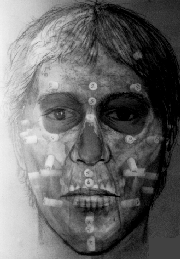 Current methods of estimating the appearance of the individual from his
or her skull can be extremely time-consuming, often resulting in a single
facial estimate being produced. This single likeness is not necessarily
the best estimate of a person's appearance, due to the difficulty involved
in determining body fat content prior to death, and of ascertaining the
appearance of features such as the nose, lips and eyes. In fact, current
success rates for identification resulting from facial reconstruction are
on the order of 50%.
Current methods of estimating the appearance of the individual from his
or her skull can be extremely time-consuming, often resulting in a single
facial estimate being produced. This single likeness is not necessarily
the best estimate of a person's appearance, due to the difficulty involved
in determining body fat content prior to death, and of ascertaining the
appearance of features such as the nose, lips and eyes. In fact, current
success rates for identification resulting from facial reconstruction are
on the order of 50%.
The development of a software application which can produce a
three-dimensional facial reconstruction of an individual would be of benefit
to various law enforcement agencies, by allowing faster, easier and more
efficient generation of multiple representations of an individual. These
varied likenesses would take into account differences in facial appearance
due to body fat content and facial features such as the eyes, nose and lips,
which are difficult to reconstruct accurately solely from cranial information.
The goal is to improve the success rates for victim or suspect identification,
based on the assumption that one of the multiple likenesses will most closely
approximate the individual's actual appearance, thus facilitating recognition
by family, friends or acquaintances.
A prototype application has been developed which makes use of current
3D graphics technology to produce a three-dimensional reconstruction of the
head.
A 3D digitized model of the skull is read
in by the application. Dowels that simulate tissue thickness are then
interactively placed and oriented by the user.
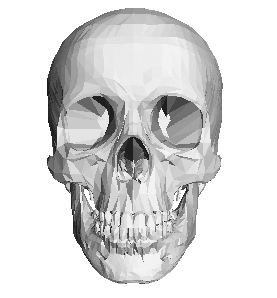
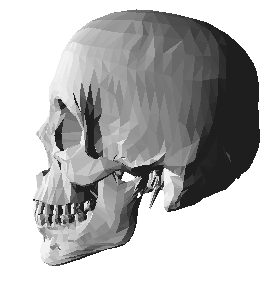
Figure 1: Digitized Skull
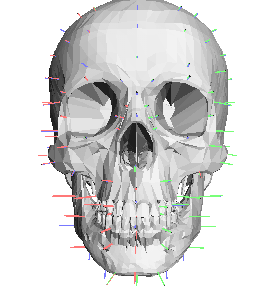
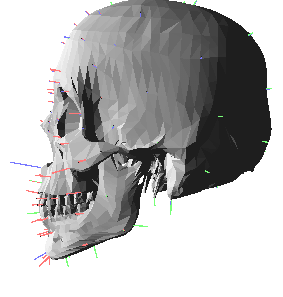
Figure 2: Digitized Skull With Dowels
A generic facial model, created using hierarchical B-splines,
is placed over the skull model. This generic face is then fit to the
dowels, resulting in the final facial estimate.
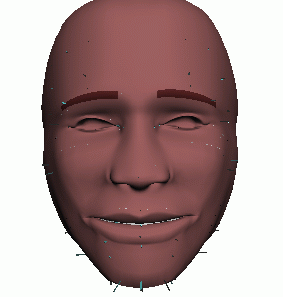
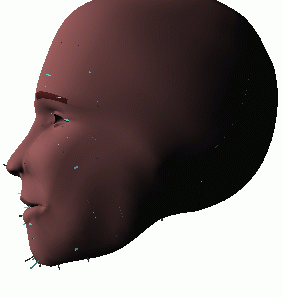
Figure 3: Generic Face Before Fitting
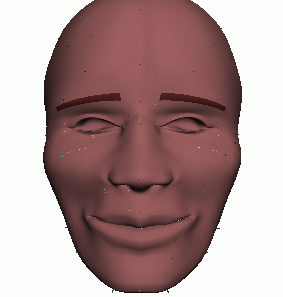
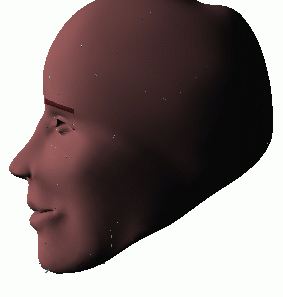
Figure 4: Final Facial Approximation
This is a prototype application. Many more dowels than the
standard set are needed to produce a good smooth fit. However, the addition
of extra dowels will eventually be automated, so that dowel placement on the
skull model will not be more time-consuming than dowel placement on an
actual physical cast of the skull.
As well, the facial surface is editable after fitting, so the
artist can modify such features as nose and lips. The lengths of the
dowels can be automatically updated to reflect race, gender and
body fat content.
Katrina Archer, karcher@acm.org

 Current methods of estimating the appearance of the individual from his
or her skull can be extremely time-consuming, often resulting in a single
facial estimate being produced. This single likeness is not necessarily
the best estimate of a person's appearance, due to the difficulty involved
in determining body fat content prior to death, and of ascertaining the
appearance of features such as the nose, lips and eyes. In fact, current
success rates for identification resulting from facial reconstruction are
on the order of 50%.
Current methods of estimating the appearance of the individual from his
or her skull can be extremely time-consuming, often resulting in a single
facial estimate being produced. This single likeness is not necessarily
the best estimate of a person's appearance, due to the difficulty involved
in determining body fat content prior to death, and of ascertaining the
appearance of features such as the nose, lips and eyes. In fact, current
success rates for identification resulting from facial reconstruction are
on the order of 50%.






